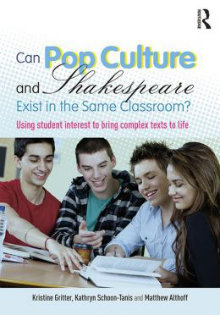When Shakespeare Meets Pop Culture in Class
Can Pop Culture and Shakespeare Exist in the Same Classroom? Using Student Interest to Bring Complex Texts to Life
By Kristine Gritter, Kathryn Schoon-Tanis, and Matthew Althoff
(Routledge, 2014 – Learn more)

Picture this: You’ve just handed out the play Romeo and Juliet by Shakespeare to your class. You tell your students to read the first few pages of Act I, and then they are going to discuss what they’ve read together as a class.
Their eyes glaze over as they read over the first page, especially if Shakespeare is “new language” to them. But Romeo and Juliet is your favorite play by the Bard, and you just know that the students will love it also. Your heart is palpitating, and you can’t wait for them to finish so that you can start discussing the story with your students. How could a play about young love and friendship, along with a little intrigue and violence, not engage your students?

What’s in the book
In classes to prepare to become a teacher, how to actually lead a discussion usually isn’t taught. In fact, in this book, the authors write that “Literature discussions, sadly, are not a common practice in secondary schools.” (15) However, if you want a student to do a close reading of a text, you need to teach them how to read the book and prepare for a discussion.
Gritter, Schoon-Tanis and Althoff tell us not only how to set up different discussion formats, but also how to provide prior knowledge for the students by using what they already know… popular culture. From West Side Story to Aladdin, Madonna to Taylor Swift, the themes of Romeo & Juliet (and other Shakespeare plays) emerge again and again.
The book is divided into seven chapters:
1. A Different Way of Teaching Literature
2. How to Improve Literature Discussions With Popular Culture
3. Literary Discussion and the Common Core State Standards
4. Using Popular Culture as a Bridge to Complex Texts
5. What Rich Discussion Looks Like and How to Set it Up
6. Successful Discussions and Classroom Democracy in Action
7. Pop Culture and Media Literacy
Insights and reflections
One of my favorite things about this book: the authors include “pedagogical insights” throughout as teaching tips. Then they follow each one with examples from a real middle school classroom. I found myself taking explanatory notes on these insights in order to remember them later. The insights are highlighted and blocked in a different shade, making it easy to read them in sequence or find them again. After each chapter the authors also included reflection questions that prompted me to think about how I would use the information in that chapter in my own classroom.
Can Pop Culture and Shakespeare Exist in the Same Classroom? includes a complete 7th grade unit based on Madeleine L’Engle’s A Wrinkle in Time. The unit helps the reader see how popular culture can be used to strengthen prior knowledge and engage students more deeply while teaching a classic book. The authors included the big questions for the unit and suggested activities. I also found the rubrics for discussion helpful. I enjoyed the assessment strategy of using stations – each with discussion questions and activities – and letting students rotate around instead of relying entirely on whole class discussions. You could use this stations idea while studying a short story, poem or other text.
Reservations
One complaint that I have about this book was that most of it seemed to be written as a college text. Although I appreciate books that are based on research, the first third is based on theory. When I realized that, I tried reading it from the viewpoint of a new teacher. As a veteran teacher, I found the last half of the book more helpful because there were ideas that I could take into my own classroom the next day.
Also, I wish the book had included examples of how to incorporate pop culture with short stories, poetry, and especially non-fiction articles. With the Common Core State Standards being put into practice, bringing pop culture into non-fiction reading will also be helpful to provide prior knowledge for students.
Pop culture: a big assist with complex text
The next time you decide to read a classic piece of literature with your students, think about using popular culture to help set the stage. The book title, Can Pop Culture and Shakespeare Exist in the Same Classroom? asks a great question, and the answer is YES. By bringing pop culture into your lesson planning, you won’t have a classroom that is silent during the discussion of a difficult text; the students will be excited to talk about the connections they can make to their own lives.
Judi Holst is an 8th grade Language Arts teacher in Colorado. She is a Curriculum Instructional Leader, a Discovery Education STAR Ambassador, and the Gifted & Talented Lead in her district. She has been in the teaching field for 22 years and has taught grades Kindergarten through 8th grade. She has presented at the AMLE Conference, International Reading Association Conference, and the Colorado Council International Reading Association Conference. You can read her teaching blog at http://tbdteacher.tumblr.com/.


































